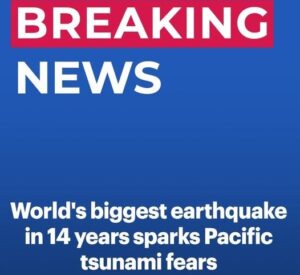Powerful 8.8 Quake—Largest in Over a Decade—Unleashes Tsunami Fears Across the Pacific

A massive 8.8 magnitude earthquake struck beneath the Pacific Ocean late Tuesday, sending shockwaves across multiple continents and sparking tsunami alerts from Russia to the west coast of the United States. It’s being described as the most powerful seismic event the region has seen in 14 years.
The quake struck at approximately 7:24 PM EST, with its epicenter located around 84 miles southeast of Russia’s Kamchatka Peninsula, according to the U.S. Geological Survey (USGS). The tremor’s immense energy rippled outward almost instantly — shaking the Earth’s crust, crashing into coastlines, and leaving governments scrambling to issue rapid warnings.
Russia and Japan Hit First
Eastern Russia bore the immediate brunt, as tsunami waves slammed into coastal towns just minutes after the earthquake. Videos from Kamchatka show water engulfing buildings, sweeping through streets, and prompting panicked evacuations. Local news agencies confirmed several injuries — including at least one woman who was hurt after jumping from a window in fear.
Japan, still haunted by the catastrophic 2011 disaster, activated its early warning systems as tsunami waves began breaching seawalls in coastal cities. Emergency sirens blared, and loudspeakers urged residents to move to higher ground. Trains were halted, power was cut in some districts, and live footage showed entire communities in motion, racing against the incoming waves.
U.S. West Coast on High Alert
The National Weather Service (NWS) has now escalated its warnings, moving large parts of the U.S. Pacific coastline from “watch” to “advisory” status. This includes California, Oregon, Washington, Hawaii, and Guam — where officials are urging residents to stay far away from beaches, bays, and low-lying coastal roads.
According to the NWS, tsunami waves may arrive along U.S. shores as early as 4:00 AM EST, with unpredictable strength and timing. While officials stressed that the advisory level doesn’t yet indicate a destructive tsunami is certain, the evolving nature of the threat means caution is critical.
“Even modest waves can carry dangerous currents and debris,” said NOAA’s West Coast Tsunami Center in an early morning alert.
Chaos on Social Media
Footage is already circulating online showing mass evacuations, heavy coastal flooding, and dramatic scenes of residents scrambling to safety. From Russian dock workers abandoning ships to Japanese commuters rushing toward emergency shelters, social media has become a live-stream of humanity in motion.
“I’ve never seen water rise so fast,” one user posted from Japan’s Hokkaido region. “It was like watching the sea come alive.”
Another clip from California shows police clearing beachside bars as alarm sirens echoed into the night.

Global Watch
Beyond the U.S., tsunami alerts were also issued across the Philippines, Indonesia, Mexico, Peru, Chile, Taiwan, and Ecuador. While wave projections differ based on location, every nation within the Pacific Ring of Fire is watching the situation with heightened urgency.
In Hawaii, sirens began blaring shortly after 7:30 PM local time, and emergency shelters opened within an hour. Officials have confirmed that Oahu’s Emergency Management Agency has activated its command center and is coordinating with federal partners to manage the evolving threat.
“We’re dealing with one of the most serious tsunami threats in recent memory,” a spokesperson for the Hawaiian governor’s office said.
What You Should Do
If you live near the coast in any of the advisory zones, authorities urge you to move inland or seek higher ground. Avoid going near the water “to watch” the waves — tsunami behavior is often deceptive and can be fatal.
The National Tsunami Warning Center emphasized that tsunami waves may come in a series, with the first wave not always being the largest. Residents should remain alert for several hours and follow official guidance.
This is a rapidly developing story. Authorities worldwide are continuing to monitor the aftershocks and oceanic patterns closely.
⚠️ If you’re in an affected area, please prioritize safety and avoid all shoreline areas. Share this information with others to help spread the word.